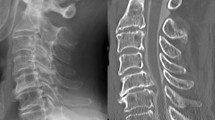Abstract
Cervical spondylosis myelopathy (CSM) is a degenerative disorder of the cervical spine’s disks and joints, leading to neurological disability. Typically, this condition causes increasing discomfort and neurologic deterioration. Cervical spine pain disease classification using deep learning can assist medical professionals in making early and more precise medical diagnosis of cervical abnormalities. The main focus of the assessment for doctors is the classification of cervical spine diseases from X-rays images, which is valuable for patients to indicate the various symptoms they are faced with. Identifying cervical spine pain injuries (CPI) is a critical aspect of the diseases segmentation and classification. Manually explaining the high-dimensional feature space makes it challenging to identify the exact category and level of severity. This paper introduces a Convolutional Neural Networks (CNN) concatenation feature extraction method to help in the diagnosis of cervical spine pain disease from X-ray images. An innovative CNN-concatenation model-based fully connected classifier and a four-class system are applied to classify X-ray image data in this research. The CNN approach is employed to automatically classify X-ray images into healthy (normal) and with cervical spine disease (abnormal). CSM is currently diagnosed mostly through clinical evaluation using imaging methods such as X-ray and computed tomography (CT). Due to its inexpensive cost and minimal radiation dose, X-ray is commonly used. The proposed approach achieved a training accuracy of 99.98%, a validation accuracy of 98.29%, and a testing accuracy of 97.82% of classification from experiments. These results indicate that the image preprocessing, data augmentation, and CNN approaches provide an efficient classification method for identifying and accurately classifying cervical spine diseases.








Similar content being viewed by others
Data availability
The datasets generated during and/or analysed during the current study are not publicly available but are available from the corresponding author on reasonable request.
Code availability
Not applicable.
Abbreviations
- CNN:
-
Convolutional Neural Networks
- CSM:
-
Cervical spondylosis myelopathy
- CT:
-
Computed Tomography
- CPI:
-
Cervical spine pain injuries
- UoGCSH:
-
University of Gondar Comprehensive Specialized Hospital
- CSCI:
-
Cervical spinal cord injury
- CR:
-
Compression ratio
- ISI:
-
Increased signal intensity
- MRI:
-
Magnetic resonance imaging
- CSCI:
-
Cervical spinal cord injury
References
Kalinowski P, Czerska B (2007) Epidemiologia urazów wśród hospitalizowanych w 2006 roku w 6. Szpitalu Wojskowym w Dęblinie. Problemy Higieny Epidemiologii 88(4):455–460
Biluts H, Abebe M, Laeke T, Tirsit A, Belete A (2015) Pattern of spine and spinal cord injuries in Tikur Anbessa Hospital, Ethiopia. Paraplegia 103:26–27
Altini N et al (2021) Segmentation and identification of vertebrae in CT scans using CNN, k-means clustering and k-NN. In Inf 8(2):40
Ma S, Huang Y, Che X, Gu R (2020) Faster RCNN-based detection of cervical spinal cord injury and disc degeneration. J Appl Clin Med Phys 21(9):235–243
W. H. Organization and I. S. C. Society, International perspectives on spinal cord injury. World Health Organization, 2013
Chitte PP, Gokhale UM (2017) Analysis of different methods for identification and classification of cervical spondylosis (cs): A survey. Int J Appl Eng Res 12(21):11727–11737
Zhang M-Z et al (2022) Predicting postoperative recovery in cervical spondylotic myelopathy: construction and interpretation of T2*-weighted radiomic-based extra trees models. Eur Radiol 32(5):3565–3575
Ji B et al, (2023) Detection of cervical spondylotic myelopathy based on gait analysis and deterministic learning. ArtifIntell Rev pp 1–17
Ayalew AM, Bezabih YA, Abuhayi BM, Ayalew AY (2024) Atelectasis detection in chest X-ray images using convolutional neural networks and transfer learning with anisotropic diffusion filter. Inf Med Unlocked 45:101448
Lee GW, Shin H, Chang MC (2022) Deep learning algorithm to evaluate cervical spondylotic myelopathy using lateral cervical spine radiograph. BMC Neurol 22(1):1–5
Rehman F, Shah SIA, Gilani SO, Emad D, Riaz MN, Faiza R (2019) A novel framework to segment out cervical vertebrae. In 2019 2nd International Conference on Communication, Computing and Digital systems (C-CODE), 2019: IEEE, pp 190–194
Merali Z, Wang JZ, Badhiwala JH, Witiw CD, Wilson JR, Fehlings MG (2021) A deep learning model for detection of cervical spinal cord compression in MRI scans. Sci Rep 11(1):1–11
Fard AP, Ferrantelli J, Dupuis A-L, Mahoor MH (2022) Sagittal cervical spine landmark point detection in x-ray using deep convolutional neural networks. IEEE Access 10:59413–59427
Ayalew AM, Salau AO, Tamyalew Y, Abeje BT (2023) X-Ray image-based COVID-19 detection using deep learning. Multimed Tools Appl 82:44507–44525. https://doi.org/10.1007/s11042-023-15389-8
Tamyalew Y, Salau AO, Ayalew AM (2023) Detection and classification of large bowel obstruction from X-ray images using machine learning algorithms. Int J Imag Syst Tech 33(1):1–17. https://doi.org/10.1002/ima.22800
Salau AO, Markus ED, Assegie TA, Omeje CO, Eneh JN (2023) Influence of class imbalance and resampling on classification accuracy of chronic kidney disease detection. Math Modell Eng Prob 10(1):48–54. https://doi.org/10.18280/mmep.100106
Ayalew AM, Salau AO, Abeje BT, Enyew B (2022) Detection and classification of COVID-19 disease from X-ray images using convolutional neural networks and histogram of oriented gradients. Biomed Signal Process Control 74:103530
Jain S, Salau AO (2023) Robust computational model for diagnosis of mitogenic activated protein kinase leading to neurodegenerative diseases. Curr Sign Trans Ther 18(1): 18:e210323214831. https://doi.org/10.2174/1574362418666230321152206
Acknowledgements
Not applicable.
Funding
Authors declare no funding for this research.
Author information
Authors and Affiliations
Corresponding author
Ethics declarations
Competing interests
The authors declare that they have no competing interests.
Additional information
Publisher's Note
Springer Nature remains neutral with regard to jurisdictional claims in published maps and institutional affiliations.
Rights and permissions
Springer Nature or its licensor (e.g. a society or other partner) holds exclusive rights to this article under a publishing agreement with the author(s) or other rightsholder(s); author self-archiving of the accepted manuscript version of this article is solely governed by the terms of such publishing agreement and applicable law.
About this article
Cite this article
Bezabh, Y.A., Salau, A.O., Abuhayi, B.M. et al. Classification of cervical spine disease using convolutional neural network. Multimed Tools Appl (2024). https://doi.org/10.1007/s11042-024-18970-x
Received:
Revised:
Accepted:
Published:
DOI: https://doi.org/10.1007/s11042-024-18970-x




